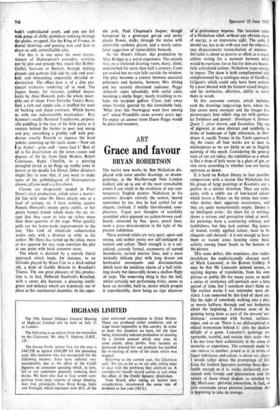Grace and favour
ART BRYAN ROBERTSON
The twelve new works by Ben Nicholson dis- played with some smaller drawings, or drawn- paintings, at the Marlborough New London Gallery add up to one of the most remarkable events I can recall in the evolution of any con- temporary English painter. Nicholson in his seventies disrupts entirely the notion,. shared sometimes by me, that he had settled for an elegant, civilised, if mildly thin-blooded, com- placency. Vague past thoughts of tastefully scumbled white pigment on golden-brown card- board, animated by fine, spare, pencil lines, seem a gross misconception in the light of the present exhibition.
These painted reliefs are very quiet, spare and strong, and neither pretty nor self-indulgent in texture and colour. Their strength is in a cal- culated, severely formal, asymmetry of curved boundaries, curved interior lines, and a most wickedly delicate play with long drawn out horizontal movements and disconnections which have the insidious charm of a ball trick- ling slowly but inexorably down a shallow flight of steps. The unnerving thing is that the ball, whilst certainly not performing tricks, seems to have an invisible, built-in, motor which propels it unpredictably, there being no sign whatever
of -a preliminary impetus. The inviolate calm of a Nicholson relief, without any obvious signs
of energy, is an impressive sight. The calm, I should say, has to do with ease and the objective (not dispassionate) reconciliation of tensions:
this calm is about as passive or effete as a crack athlete resting for a moment between what
would be exertions for us but for him are beauti-
fully articulated actions. Nicholson traps energy in repose. The show is both complimented and
complemented by a catalogue essay of Geoffrey Grigson's which could only have been written by a poet blessed with the keenest visual insights and the instinctive, effortless, ability to catch them in words.
In this awesome context, which includes even the drawings (engravings here, where the line seems more resonant and the images less
picturesque), four reliefs sing out with particu-
lar freshness and power: Dordogne 4. Zennor Quoit 2, silver brown, and Saronikos. The use
of pigment, at once abstract and symbolic in
terms of landscape or light references, in Dor- dogne 4, recalls Turner in his Yacht approach-
ing the coast; all four works are as near to masterpieces as we are likely to see in English painting of this epoch. Considering the general state of our art today, the exhibition as a whole is like a drop of holy water in a glass of gin, or vice versa according to whether you are facing upstream or down.
It is hard on Robyn Denny to face possible comparisons with a master like Nicholson, but his group of large paintings at Kasmin's are a gesture in a similar direction. They are calm, quiet, with a subtle use of low-keyed colour which leaves a flicker on the retina that some- what denies their apparent evasiveness, and they are quite monumentally empty. Denny is an intelligent artist: his short list of writings shows a serious and perceptive mind at work, his paintings have a convincing sobriety and tastefulness, but they lack content. Big spaces of muted, evenly applied colour, have to be eloquent and charged: it is not enough to leave them as vacant areas housing some basic activity among linear bands in the bottom of the picture.
This same defect, this emptiness, also rather invalidates the sophisticatedly abstract work of Mark Lancaster, at the Rowan Gallery. It may be that Mr Lancaster painted scenes, in varying degrees of translation, from his own private or public life for many years, or made a series of revelatory self-portraits over a long period of time, but I somehow don't think so. The earliest works I can remember were ab- stract. I am unnerved by this kind of short cut. like the sight of somebody walking into a play or movie halfway through and not bothering about the beginning. I distrust most of the painting being done as part of the present 'art- dialogue,' concerned with format, surfaces.
edges, and so on. There is no philosophical or ethical momentum behind it: only the shallow delight of a game. Lancaster's paintings are agreeable, tasteful, and sustain their scale—but I do not trust their authenticity in the sense of maturity or experience. The comment made by one canvas to another, joined to it, in terms of linear imbalance and colour, is about art, where
I would rather detect the promptings of life.
Even the liveliest figurative painting these days. feeble enough as it is, seems exclusively con-
cerned with format and presentation and the nature of those visual slogans so extolled by
MacLuan: pictorial journalism, in fact, or trite comments about pictorial journalism. Art is beginning to take its revenge.






























 Previous page
Previous page